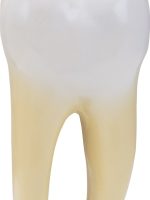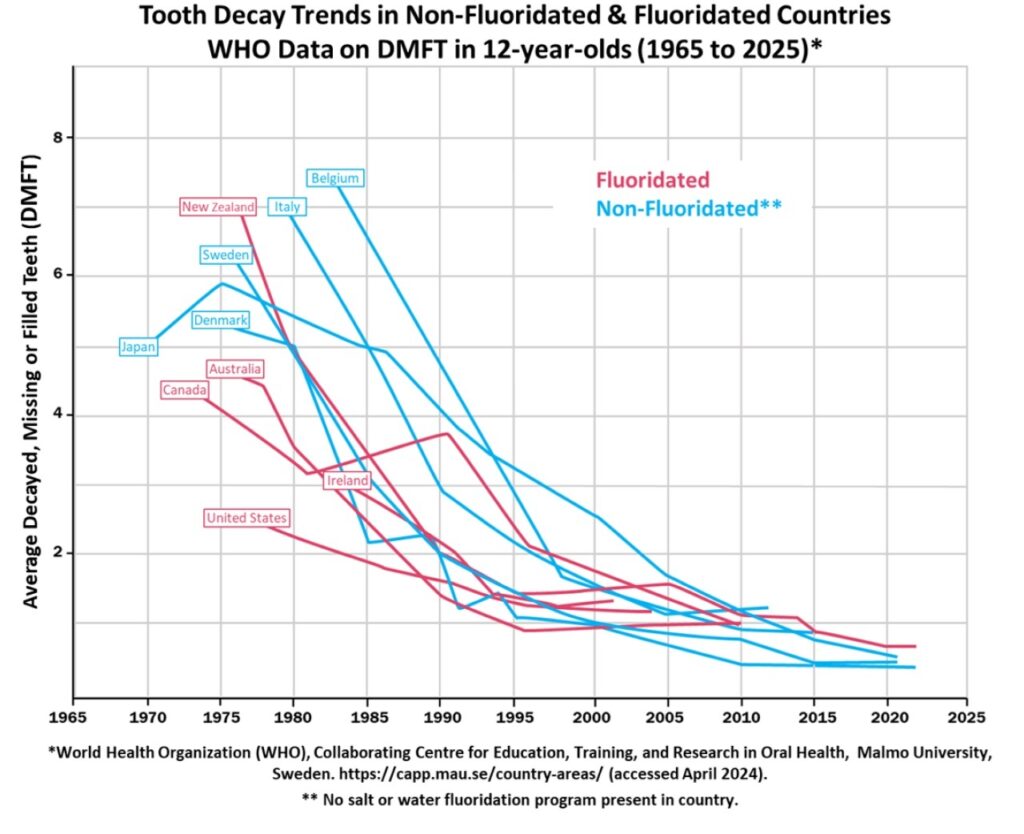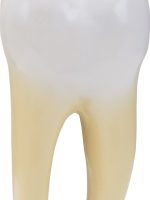Fluoridation - Mega Health Fraud - No benefits and major health safety issues

Fluoridation doesn't make a difference to tooth decay
Since 1945, fluoride has been added to tap water, supposedly to prevent dental cavities and promote strong, healthy teeth. Currently ~ 70% of U.S. water supplies contain fluoride for >170 million Americans to drink. A 2010 study found that the protective shield formed on teeth by this renowned cavity-fighter is up to 100 times thinner than previously believed. It has been long-touted that fluoride changes hydroxyapatite (the main mineral in tooth enamel) into a more-decay resistant material called fluorapatite. But this research found that the fluorapatite layer formed in this way is only 6 nm thick (1/10,000th the width of a human hair).
Such a thin layer is quickly worn away by ordinary chewing, so how can it protect teeth from decay?
Frank MuÌller, Christian Zeitz, Hubert Mantz, Karl-Heinz Ehses, Flavio Soldera, Jörg Schmauch, Matthias Hannig, Stefan Hüfner, Karin Jacobs. Elemental Depth Profiling of Fluoridated Hydroxyapatite: Saving Your Dentition by the Skin of Your Teeth? Langmuir, 2010; 26 (24): 18750 Online Link
Fluorides have little or no effect on decay prevention in humans! In 1990 Dr. John Colquhoun was forced into early retirement in New Zealand after he conducted a study on 60,000 school children and found no difference in tooth decay between fluoridated and unfluoridated areas. He additionally found that a substantial number of children in fluoridated areas suffered from dental fluorosis. He made the study public.

Additive fluorides are having toxic effects
Fluoride in water linked to lower IQ in children
“About 28 percent of the children in the low-fluoride area scored as bright, normal or higher intelligence compared to only 8 percent in the ‘high’ fluoride area … in the high-fluoride city, 15 percent had scores indicating mental retardation and only 6 percent in the low-fluoride city.”
Animals in southern Iceland are at risk of fluoride poisoning if they inhale or ingest the ash from the recent volcanic eruption. According to BBC News April 19, 2010:“The fluoride in the ash creates acid in the animals’ stomachs, corroding the intestines and causing hemorrhages. It also binds with calcium in the bloodstream and after heavy exposure over a period of days makes bones frail, even causing teeth to crumble.”
Water fluoridation has been banned in Sweden, Norway, Denmark, West Germany (now unified), Italy, Belgium, Austria, France, and The NetherlandsStudies show that consuming fluoridated water might actually CAUSE tooth decay
Children who drank water containing high levels of natural fluoride (3 ppm), had MORE tooth decay than children in other parts of South Africa who drank much lower concentrations (between 0.19 to 0.48 ppm). According to a study published in the September 2001 issue of International Journal of Pediatric Dentistry,
And fluoride-saturated American teenagers had twice the rate of cavities as the South African children drinking low levels of natural fluoride!
Some horrifying health-effects of fluoridation
Pharmaceutical grade sodium fluoride is a dangerous toxin that can cause serious physical harm According to information from from the National Institute of Occupational Safety and Health(NIOSH)and its Material Safety Data Sheet (MSDS). Sodium fluoride targets your:
- Kidneys
- Heart
- Gastrointestinal system
- Bone and skeletal structures
- Teeth
- Nerves
The MSDS for sodium fluoride also states that fluoride compounds can induce:
- Systemic toxic effects on your heart, liver, and kidney
- Depleted calcium levels in your body – leading to hypocalcaemia and death
Fluoride is a cumulative poison. The MSDS points out that the toxic effect of fluoride might be delayed, and that laboratory experiments have resulted in the development of tumors.Primarily absorbed through the GI tract into the blood, it then enters the cellular tissues. An average 50% of ingested fluoride is excreted through your kidneys. The remainder accumulates in your teeth and bones, pineal gland, and other tissues, such as the aorta. In children, >50% of an ingested dose of fluoride is deposited in bone, compared to only about 10% in adults, but storage is cumulative.
Studies have shown that fluoride toxicity can lead to:
| Increased lead absorption | Disrupts synthesis of collagen | Hyperactivity and/or lethargy | Muscle disorders |
| Brain damage, and lowered IQ in children | Arthritis | Dementia | |
| Lowered thyroid function | Bone cancer (osteosarcoma) | Inactivates 62 enzymes | Inhibited formation of antibodies |
| Genetic damage and cell death | Increased tumor and cancer rate | Disrupted immune system | Damaged sperm and increased infertility |
List of references for the study-supported biological effects of fluorides at end of this article
Eating the contents of a family size tube of fluoridated toothpaste is enough to kill a 25 pound child. In 1991, the Akron (Ohio) Regional Poison Center reported that “death has been reported following ingestion of 16mg/kg of fluoride. Only 1/10 of an ounce of fluoride could kill a 100 pound adult. According to the Center, “fluoride toothpaste contains up to 1mg/gram of fluoride.” Even Proctor and Gamble, the makers of Crest, acknowledge that a family-sized tube “theoretically contains enough fluoride to kill a small child.”
Fluorides have been used to modify behavior and mood of human beings. It is a little known fact that fluoride compounds were added to the drinking water of prisoners to keep them docile and inhibit questioning of authority, both in Nazi prison camps in World War II and in the Soviet gulags in Siberia.
Fluorides are medically categorized as protoplasmic poisons, which is why they are used to kill rodents. The September 18, 1943 issue of the Journal of the American Medical Association, states, “fluorides are general protoplasmic poisons, changing the permeability of the cell membrane by inhibiting certain enzymes. The exact mechanisms of such actions are obscure.”
Fluoride consumption by human beings linked to increases in the general cancer death rate. In 1975 Dr. John Yiamouyiannis published a preliminary survey which showed that people in fluoridated areas have a higher cancer death rate than those in non-fluoridated areas. The National Cancer Institute attempted to refute the studies. Later in 1975 Yiamouyiannis joined with Dr. Dean Burk, chief chemist of the National Cancer Institute (1939-1974) in performing other studies which were then included in the Congressional Record by Congressman Delaney, who was the original author of the Delaney Amendment, which prohibited the addition of cancer-causing substances to food used for human consumption. Both reports confirmed the existence of a link between fluoridation and cancer.(Note: Obviously Dr. Burk felt free to agree with scientific truth only after his tenure at National Cancer Institute ended, since his job depended on towing the party line).
There is no scientific data that shows that fluoride mouth rinses and tablets are safe for human use. In 1989 a study by Hildebolt, et al. on 6,000 school children contradicted any alleged benefit from the use of sodium fluorides. A 1990 study by Dr. John Yiamouyiannis on 39,000 school children contradicted any alleged benefits from the use of sodium fluorides. In 1992 Michael Perrone, a legislative assistant in New Jersey, contacted the FDA requesting all information regarding the safety and effectiveness of fluoride tablets and drops. After 6 months of stalling, the FDA admitted they had no data to show that fluoride tablets or drops were either safe or effective. They informed Perrone that they will “probably have to pull the tablets and drops off the market.”
The fact that fluoride toothpastes and school based mouth rinses are packaged in aluminum, accentuates the effect on the body. In 1976, Dr. D. Allman and coworkers from Indiana University School of Medicine fed animals 1 part-per-million (ppm) fluoride and found that in the presence of aluminum, in a concentration as small as 20 parts per billion, fluoride is able to cause an even larger increase in cyclic AMP levels. Cyclic AMP inhibits the migration rate of white blood cells, as well as the ability of the white blood cell to destroy pathogenic (disease-causing) organisms.
Journal of Dental Research, Vol. 55, Sup B, p. 523, 1976, ” Effect of Inorganic Fluoride Salts on Urine and Tissue Cyclic AMP Concentration in Vivo”.
(Note: It is no small accident that toothpaste tubes containing fluoride are often made of aluminum)
“Fluoridation is the greatest case of scientific fraud of this century”
– Robert Carlton, Ph.D., former U. S. EPA scientist on ” Marketplace” Canadian Broadcast Company, Nov. 24, 1992
Regarding fluoridation, the EPA should act immediately to protect the public, not just on the cancer data, but on the evidence of bone fractures, arthritis, mutagenicity and other effects”
– William Marcus, Ph. D., senior EPA toxicologist, Covert Action, Fall 1992, p. 66
Dentists, public health officials and the public have been purposefully deceived
“Oh, What a Tangled web . . .” In his book The Fluoride Deception, award winning journalist and former producer at the BBC, Christopher Bryson exposes the intertwined interests that existed in the 1940’s and 50’s between the aluminum industry, the U.S. nuclear weapons program, and the dental industry, which resulted in fluoride being declared not only safe, but “beneficial to human health.”
The fluoride in your teeth is NOT what is added to the water and toothpaste
Your teeth and bones contain a natural form of mineral fluoride. Apatite (calcium fluoro-chloro-hydroxyl phosphate). The substances in your diet and saliva maintain an equilibrium between hydroxyl-apatite (calcium phosphate) dissolving and forming in your tooth enamel.
Caries and cavities occur in your teeth when you have more calcium phosphate dissolving than being adhered.
However, it is NOT the natural “Fluoride” mineral that is added to your drinking water. it is another chemical fluoride compound . . .
There are three compounds that CAN be used for fluoridating water supplies to elevate the fluoride content of public water to 0.7 ppm, with the intention of preventing tooth decay:
1. Sodium fluoride – this form is not usually used for fluoridation, but is the form usually used for studies evaluating health risk
2. Sodium silicofluoride
3. Hydrofluorosilicic acid (most commonly used additive).
The last two are the forms that are actually used to fluoridate water, and they are chemical by-products of aluminum, steel, cement, phosphate, and nuclear weapons manufacturing. Such manmade fluoride has no nutrient value and no health benefits whatsoever.
These hazardous industrial wastes have NEVER been fully tested to determine their full potential health hazard. Instead, it is the pharmaceutical grade “sodium fluoride” (the first one on the list) that is used in most studies evaluating the risk to human health.
How much fluoride are you getting? - it's easy to overdose!
When fluoridation began, the “optimal” level of fluoride for dental benefit was determined to be 1 mg/day for an adult male. Based on an average water intake of 1 liter/day. At that level, 10% of the population (those in the high-risk group) were expected to experience fluorosis.
In addition to toothpaste and mouth wash, there are numerous other sources of fluoride:
• Food and beverages processed with fluoridated water
• Mechanically de-boned meat
• Pesticide residue on food
• Pharmaceutical drugs – esp. SSRI antidepressants and fluoroquinolone antibiotics E.g. Cipro
• Soy baby formulas
• Instant tea – scientists analyzed 10 different brands of tea at regular-strength levels in fluoride-free water. Each contained fluoride levels ranging from 1.0 to 6.5 parts per million (ppm):
| Product | Preparation | Fluoride (ppm or mg/L) | ||
|---|---|---|---|---|
| Lab. 1 | Lab. 2 | Mean | ||
| Lipton | ||||
| Instant (1999) | 2.7 | 2.6 | 2.6 | |
| Instant (2003) | 7.7 | 5.4 | 6.5 | |
| Instant decaffeinated | 3.1 | 2.4 | 2.7 | |
| Instant diet iced tea mix (decaffeinated lemon) | 1.1 | 1.0 | 1.0 | |
| Naturally decaffeinated flow-through bags | 1.9 | 2.0 | 2.0 | |
| Nestea | ||||
| Instant | 2.4 | 2.1 | 2.3 | |
| Instant decaffeinated | 2.4 | 2.2 | 2.3 | |
| Schnucks | ||||
| Instant | 1.5 | 1.0 | 1.3 | |
| Arizona | ||||
| Lemon iced tea mix | 2.5 | 1.9 | 2.2 | |
| Luzianne | ||||
| Specially blended for iced tea (bags) | 3.9 | 3.1 | 3.5 | |
Fluoride exposure levels for a 110-pound adult from food, beverages, toothpaste, and mouthwash – a 1991 review by the U.S. Department of Health and Human Services shows how drastic your overexposure might be when taking multiple sources into account.
| Fluoride Concentration in drinking water | Total fluoride intake | Percentage Over 1 mg “Optimal” dosage |
|---|---|---|
| Unfluoridated Communities < 0.3 mg/L | 0.88 – 2.20 mg/day | as much as 120 % |
| “Optimally” Fluoridated 0.7-1.2 mg/L | 1.58 – 6.60 mg/day | as much as 560 % |
| Fluoridated communities > 2.0 mg/L | 2.10 – 7.05 mg/day | possible >605 % |
How to build healthy teeth
- Limit /Eliminate sugar
- Avoid processed foods
- Eat plenty of green vegetables and vitamin K2
- Regular dental visits or alternative plaque removal methods
Professionals call for end of fluoridation
The Fluoride Action Network issued a Statement asking Congress to end water fluoridation in the United States. As of Oct, 2018, the statement was signed by over 4,800 medical, dental, scientific, and environmental professionals. Statement
References for studies on biological effects of fluorides
1. Fluoride exposure disrupts the synthesis of collagen and leads to the breakdown of collagen in bone, tendon, muscle, skin, cartilage, lungs, kidney and trachea.
A.K. Susheela and Mohan Jha, ” Effects of Fluoride on Cortical and Cancellous Bone Composition,” IRCS Medical Sciences: Library Compendium, Vol. 9, No.11, pp. 1021-1022 (1981);
Y. D. Sharma, ” Effect of Sodium Fluoride on Collagen Cross-Link Precursors,” Toxicological Letters, Vol. 10, pp. 97-100 (1982);
A. K. Susheela and D. Mukerjee, ” Fluoride poisoning and the Effect of Collagen Biosynthesis of Osseous and Nonosseous Tissue,” Toxicological European Research, Vol. 3, No.2, pp. 99-104 (1981);
Y.D. Sharma, ” Variations in the Metabolism and Maturation of Collagen after Fluoride Ingestion,” Biochemica et Biophysica Acta, Vol. 715, pp. 137-141 (1982);
Marian Drozdz et al., ” Studies on the Influence of Fluoride Compounds upon Connective Tissue Metabolism in Growing Rats” and “Effect of Sodium Fluoride With and Without Simultaneous Exposure to Hydrogen Fluoride on Collagen Metabolism,” Journal of Toxicological Medicine, Vol. 4, pp. 151-157 (1984).
2. Fluoride stimulates granule formation and oxygen consumption in white blood cells, but inhibits these processes when the white blood cell is challenged by a foreign agent in the blood.
Robert A. Clark, ” Neutrophil Iodintion Reaction Induced by Fluoride: Implications for Degranulation and Metabolic Activation,” Blood, Vol. 57, pp. 913-921 (1981).
3. Fluoride depletes the energy reserves and the ability of white blood cells to properly destroy foreign agents by the process of phagocytosis. As little as 0.2 ppm fluoride inhibits superoxide production in resting white blood cells, virtually abolishing phagocytosis. Even micro-molar amounts of fluoride, below 1 ppm, may seriously depress the ability of white blood cells to destroy pathogenic agents.
John Curnette, et al, ” Fluoride-mediated Activation of the Respiratory Burst in Human Neutrophils,” Journal of Clinical Investigation, Vol. 63, pp. 637-647 (1979);
W. L. Gabler and P. A. Leong, ., ” Fluoride Inhibition of Polymorphonumclear Leukocytes,” Journal of Dental Research, Vol. 48, No. 9, pp. 1933-1939 (1979);
W. L. Gabler, et al., ” Effect of Fluoride on the Kinetics of Superoxide Generation by Fluoride,” Journal of Dental Research, Vol. 64, p. 281 (1985);
A. S. Kozlyuk, et al., ” Immune Status of Children in Chemically Contaminated Environments,” Zdravookhranenie, Issue 3, pp. 6-9 (1987)
4. Fluoride confuses the immune system and causes it to attack the body’s own tissues, and increases the tumor growth rate in cancer prone individuals.
Alfred Taylor and Nell C. Taylor, ” Effect of Sodium Fluoride on Tumor Growth,” Proceedings of the Society for Experimental Biology and Medicine, Vol. 119, p. 252 (1965);
Shiela Gibson, ” Effects of Fluoride on Immune System Function,” Complementary Medical Research, Vol. 6, pp. 111-113 (1992);
Peter Wilkinson, ” Inhibition of the Immune System With Low Levels of Fluorides,” Testimony before the Scottish High Court in Edinburgh in the Case of McColl vs. Strathclyde Regional Council, pp. 17723-18150, 19328-19492, and Exhibit 636, (1982);
D. W. Allman and M. Benac, ” Effect of Inorganic Fluoride Salts on Urine and Cyclic AMP Concentration in Vivo,” Journal of Dental Research, Vol. 55 (Supplement B), p. 523 (1976);
S. Jaouni and D. W. Allman, ” Effect of Sodium Fluoride and Aluminum on Adenylate Cyclase and Phosphodiesterase Activity,” Journal of Dental Research, Vol. 64, p. 201 (1985)
5. Fluoride inhibits antibody formation in the blood.
S. K. Jain and A. K. Susheela, ” Effect of Sodium Fluoride on Antibody Formation in Rabbits,” Environmental Research, Vol. 44, pp. 117-125 (1987)
6. Fluoride depresses thyroid activity by replacing body’s iodine.
Viktor Gorlitzer Von Mundy, ” Influence of Fluorine and Iodine on the Metabolism, Particularly on the Thyroid Gland,” Muenchener Medicische Wochenschrift, Vol. 105, pp. 182-186 (1963);
Benagiano, “The Effect of Sodium Fluoride on Thyroid Enzymes and Basal Metabolism in the Rat,” Annali Di Stomatologia, Vol. 14, pp. 601-619 (1965);
Donald Hillman, et al., ” Hypothyroidism and Anemia Related to Fluoride in Dairy Cattle,” Journal of Dairy Science, Vol. 62, No.3, pp. .416-423 (1979);
V. Stole and J. Podoba, ” Effect of Fluoride on the Biogenesis of Thyroid Hormones,” Nature, Vol. 188, No. 4753, pp. 855-856 (1960);
Pierre Galleti and Gustave Joyet, ” Effect of Fluorine on Thyroid Iodine Metabolism and Hyperthyroidism,” Journal of Clinical Endocrinology and Metabolism, Vol. 18, pp. 1102-1110 (1958)
7. Fluorides have a disruptive effect on various tissues in the body.
T. Takamorim ” The Heart Changes in Growing Albino Rats Fed on Varied Contents of Fluorine,” The Toxicology of Fluorine Symposium, Bern, Switzerland, Oct 1962, pp. 125-129;
Vilber A. O. Bello and Hillel J. Gitelman, ” High Fluoride Exposure in Hemodialysis Patients,” American Journal of Kidney Diseases, Vol. 15, pp. 320-324 (1990);
Y. Yoshisa, ” Experimental Studies on Chronic Fluorine Poisoning,” Japanese Journal of Industrial Health, Vol. 1, pp. 683-690 (1959)
8. Fluoride promotes development of bone cancer
J.K. Mauer, et al., ” Two-Year Cacinogenicity Study Of Sodium Fluoride In Rats,” Journal of the National Cancer Institute, Vol. 82, pp. 1118-1126 (1990);
Proctor and Gamble ” Carcinogenicity Studies with Sodium Fluoride in Rats” National Institute of Environmenrtal Health Sciences Presentation, July 27, 1985;
S. E. Hrudley et al., ” Drinking Water Fluoridation and Osteosarcoma,” Canadian Journal of Public Health, Vol. 81, pp. 415-416 (1990);
P. D. Cohn, ” A Brief Report on the Association of Drinking Water Fluoridation and Incidence of Osteosarcoma in Young Males,” New Jersey Department of Health, Trenton, New Jersey, Nov. 1992;
M. C. Mahoney et al., ” Bone Cancer Incidence Rates in New York,” American Journal of Public Health, Vol. 81, pp. 81, 475 (1991);
Irwin Herskowitz and Isabel Norton, ” Increased Incidence of Melanotic Tumors Following Treatment with Sodium Fluoride,” Genetics Vol. 48, pp. 307-310 (1963);
J. A. Disney, et al., ” A Case Study in Testing the Conventional Wisdom: School Based Fluoride Mouth Rinse Programs in the USA,” Community Dentistry and Oral Epidemiology, Vol. 18, pp. 46-56 (1990);
D. J. Newell, ” Fluoridation of Water Supplies and Cancer – An Association?,” Applied Statistics, Vol. 26, No. 2, pp. 125-135 (1977)
9. Fluorides cause premature aging of the human body
Nicholas Leone, et al., ” Medical Aspects of Excessive Fluoride in a Water Supply,” Public Health Reports, Vol. 69, pp. 925-936 (1954);
J. David Erikson, ” Mortality of Selected Cities with Fluoridated and Non-Fluoridated Water Supplies,” New England Journal of Medicine, Vol. 298, pp. 1112-1116 (1978);
” The Village Where People Are Old Before Their Time,” Stern Magazine, Vol. 30, pp. 107-108, 111-112 (1978)
10. Fluoride ingestion from mouth rinses and dentifrices in children is extremely hazardous to biological development, life span and general health
Yngve Ericsson and Britta Forsman, ” Fluoride Retained From Mouth Rinses and Dentifrices In Preschool Children,” Caries Research, Vol. 3, pp. 290-299 (1969);
W. L. Augenstein, et al., ” Fluoride Ingestion In Children: A Review Of 87 Cases,” Pediatrics, Vol. 88, pp. 907-912, (1991);
Charles Wax, ” Field Investigation Report,” State of Maryland Department of Health and Mental Hygiene, March 19, 1980, 67 pages;
George Waldbott, ” Mass Intoxication from Over-Fluoridation in Drinking Water,” Clinical Toxicology, Vol. 18, No.5, pp. 531-541 (1981)















